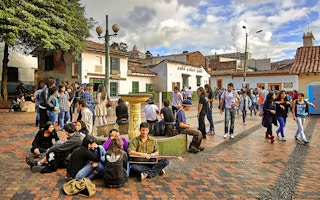We are now 13 months into the 15-year lifespan of the Sustainable Development Goals (SDGs) – early enough that much of the framework for implementation has still to be put in place and for residual optimism, but far enough forward to expect some green shoots of potential and preliminary evidence of impact.
The goals set out a shared aspiration for a global-scale transition towards greater sustainability and equity through aggregating multiple overlapping actions from local to international levels.
So what’s the prognosis after year one?
The world has indeed seen huge political shifts over the last year, though most do not support the core agenda of the SDGs. In the UK for example, the goals have received little public attention, which is unlikely to change as the Brexit fallout continues to dominate political discourse.
While many countries are paying lip service to the SDGs’ importance, some countries have made solid commitments and set out clear road maps for turning the goals into action.
Multilateralism under strain
But the events of 2016 have shaken confidence in multilateralism, with consensus-based processes such as the SDGs coming under increasing scrutiny.
Do the goals respond to the aspirations of ordinary people, who are often suspicious of ‘elites’ and see little evidence that their lives are getting better? Are the SDGs sufficiently influential or visible to challenge a top-down model that concentrates power and money far away from the grassroots?
IIED recognises the need for international agreements to realise collective action at a global level, and give legitimacy to local and national initiatives.
We also recognise that a fairer, more sustainable world starts with change that emerges from local priorities. And it is engaged and empowered citizens who drive this change.
So what difference will these goals really make for people grappling with the trade-offs and dilemmas that dominate politics in every part of the planet?
Tracking progress
We recently conducted a series of interviews with people across the world closely involved in sustainable development efforts. Their reflections provide an important measure of the SDGs’ potential to help frame collective action across a spectrum of issues and contexts, and also how they connect with longer-established and more rooted institutions and processes (see the briefing paper ‘Reconceiving the SDGs as a political force for change‘).
We have also been working closely with an international network of evaluation experts to understand what information policymakers, parliamentarians and citizens need in order to decide how to achieve the SDGs (see the series of briefings on ‘Effective evaluation for the SDGs‘).
Their key reflections will help prioritise SDG action for the next year or two:
- There is little public demand for the SDGs as an international action plan, but the issues they set out are widely recognised: for example, only seven per cent of the UK population have heard of the goals, despite a high profile awareness-raising campaign. However, people around the world are pushing for concerted action on climate change, economic and social inequality, and environmental degradation.
- While many planning departments are on board with sustainable development, economic ministries are less engaged: there is an apparent disconnect between development and spatial plans (which are often strongly oriented to sustainable development) on the one hand, and the priorities that guide high-level decision-making (which frequently prioritise macroeconomic objectives over sustainability concerns) on the other.
- Aligning existing policy initiatives and cycles and SDG action makes a real difference: Jamaica already has a national ‘Vision 2030’ so the SDGs add little to the established targets and priorities. However, as a small island state, Jamaica needs strong international partnerships.
The SDGs can help make the case for financial and political support, and raise awareness of particularly pressing issues that might otherwise not get attention. But there is also a danger of tedium with international agendas, and demands for reports and data from the global level diverting capacity and weakening efforts to achieve Vision 2030.
- The SDGs don’t provide answers, but they do set out the basis for a rational and evidence-based debate on development choices: even experienced planners can struggle to assess options and make informed choices, and in relation to sustainable development they often don’t have the mix of tools required.
For example, one interviewee described the two possible pathways for pursuing ‘sustainable agriculture’ in his country – by improving resource efficiency through mechanisation, or by improving equity through creating jobs.
The challenge his country faces is to balance social, environmental and economic objectives, to somehow bring in all stakeholders, and to make decisions despite this complexity. The SDGs don’t provide easy solutions to these kinds of issues, but they can help frame the choices, dilemmas and trade-offs more coherently.
“
A fairer, more sustainable world starts with change that emerges from local priorities. And it is engaged and empowered citizens who drive this change.
- A siloed approach to planning makes it hard to deal with ‘wicked problems’: India is one of many countries to divide responsibility for individual goals across ministries. But it’s hard for a single ministry to address complex challenges without working alongside other ministries. It is also very difficult politically to move from established sectoral governance institutions to more integrated, cross-cutting alternatives.
Colombia has employed a whole-government approach to address the country’s major challenges (from peace-building to achieving greater social equity and environmental sustainability). Some commentators suggest that the peace process that ended Colombia’s long insurgency has opened up the space to make major changes to institutions and ways of working.
For countries not undergoing political shifts on this scale, change may be more difficult – though Germany has just released a major plan that focuses primarily on domestic action to achieve the SDGs (PDF in German/auf Deutsch).
- Data quality and availability is important, but it is vital to have the capacity and political space to assess and evaluate what it means. And high-quality, well-organised evidence of how sustainable development approaches have evolved, how they work and how they have enabled nationally and politically important outcomes could help convince decision makers.
Tom Bigg is head of the Strategy and Learning Group at IIED. This post was originally published from the IIED blog.











